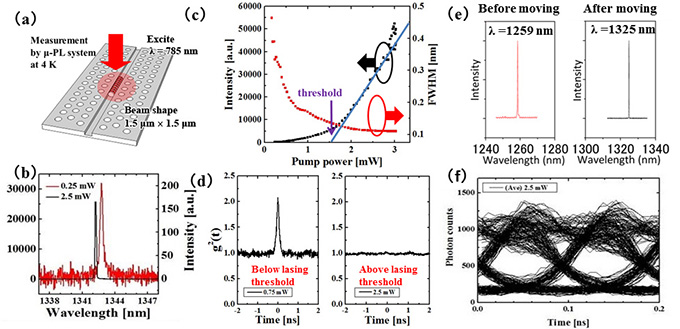Subwavelength Nanowire-induced Silicon Photonic Crystal Lasers
While many nanowire (NW) lasers have been demonstrated at visible and near-visible wavelengths, it is difficult to make nanowire lasers that operate in telecom-bands because the gain is too small. In this study, we devised an NW induced photonic crystal cavity by using atomic force microscopy [Fig. 1(a)] [1] and demonstrated telecom-band nanowire lasers on Si. This is a new technique to build nano-lasers in Si photonic circuits [2,3].
In the experiment, the number of quantum wells in each NW was increased to 100 to increase the gain volume. In addition, the quality of the NW’s crystal was improved so that the polarization of the intrinsic emission of the nanowire could be optimized to the cavity polarization therefore increasing the extraction efficiency. The NW was 2.5 µm long and about 111 nm in diameter. The emission was at about 1330 nm. Figure 1(b) shows the spectrum of a NW laser under 0.25 and 2.5 mW continuous wave (CW) pumping conditions at 4K. Figure 1(c) shows the light-in vs light-out (L-L) property and full width at half maximum. It shows a kink structure in the L-L plot and that indicates lasing. We also measured photon statistics [Fig. 1(d)] and confirmed that the sample truly achieves CW lasing [3]. The lasing wavelength can be tuned by moving the NW [Fig. 1(e)] [1,2]. Next we estimated the dynamic property of the laser. The single NW laser was pumped by a modulated laser (pseudo-random bit sequence), and the signal from the NW laser was measured with a superconducting single photon detector. It is generally difficult to measure a modulation signal in micro-photoluminescence because the coupling efficiency to the vertical direction is very low. However our measurement system is very sensitive and makes it possible to obtain the signal. We also obtained 10 Gbps opened eye-pattern from the measured modulated signal [Fig. 1(f)] [3]. This is the first demonstration of directly modulated nanowire lasers.
- [1] M. D. Birowosuto et al., Nature Mater. 13, 279 (2014).
- [2] A. Yokoo, M. Takiguchi et al., ACS Photonics 4, 355 (2017).
- [3] M. Takiguchi et al., APL Photonics 2, 046106 (2017).

|
| Fig. 1. (a) Schematic image. (b) PL spectrum. (c) L-L. (d) Photon correlation. (e) Tuned spectrum. (f) Eye diagram. |